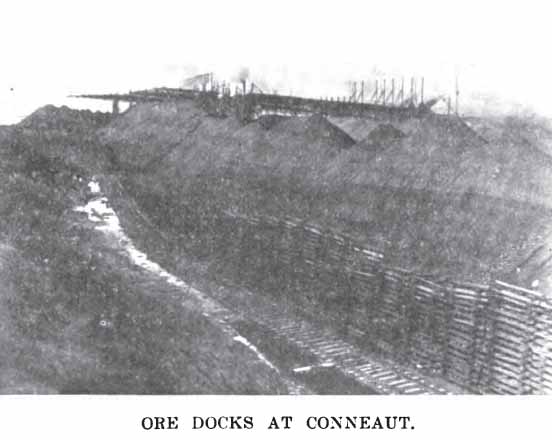|
Conneaut, Ohio History Source: History of Western Reserve Conneaut was one of the
first towns settled in Ashtabula county. Thomas Montgomery
and Aaron Wright were the pioneers. They were from
Harpersfield, New York, and had expected to settle with friends at
Harpersfield, but when they passed through Conneaut they were so
pleased with the place they stopped. Their settling was the
easiest of the pioneers because they occupied the two houses which
the surveyors had built and found land which had been worked both by
the Indians and Stowe, who had charge of the provisions of
the surveying party. As early as 1786, a squatter named
Halsted was in East Conneaut very near the state road. He,
the Kingsburys and surveyors had preceded Aaron Wright,
but they were not actual settlers. A HUNTER'S ADVENTURE One of the most interesting events occurring to a resident of Conneaut was the adventure of Mr. Sweatland, who lived near the mouth of Conneaut creek. It was from this creek which the Seneca Indians named Conneaut, meaning "many fish," that the town took is name. Mr. Sweatland was a great sportsman and delighted in taking deer. He and a neighbor, Mr. Cousins, arranged that the latter should go into the woods with his dog, start the deer towards the lake, and that Sweatland should capture it from his dug-out. On a certain fall morning this program was partially carried out. Mr. Cousins chased a lusty stag into the water and Sweatland began chasing it in his clumsy boat. So intent was the man on capturing the animal, and so strong was the latter, before he realized it the hunter was far out into the lake. The stag turned for the shore and when the man attempted to follow he found a high wind had arisen and that he could make no headway against it. He could still see the shore, but could not attain it. He was young and brave and strong and did not despair, and was buffeted about for thirty(?) hours and then landed on the Canadian shore forty miles from any inhabitants. Although pretty well exhausted, he managed to reach a hamlet, was fed and cared for, and later took passage for Ashtabula Harbor, and upon his arriving home learned that his funeral sermon had been preached and his wife donned mourning garments. CONNEAUT HARBOR IN 1850. In 1850, Conneaut Harbor was an active place. As some of the largest ships on the lake were built here, the getting out of the lumber for the same was quite an industry. Mr. A. L. Webster, of Danville, Illinois, writes: "About 1850 Conneaut Harbor was the scene of quite an activity in shipbuilding. Some of the best vessels sailing the lakes were built in the Conneaut shipyard, and Conneaut was the home of scores of lake captains, whose names were familiar form Buffalo to Chicago. The writer recalls the names of Captains C. W. Appleby, M. Capron, L. B. Goldsmith, Harrison Perry and Charles Howard, Cyrenus Blood, James Tubbs, Andrew Lent, Orange Capron, Captain DeWolf, Wiard, Foster, Travers, Wood; and there were many more. In those days the regions about the Harbor were covered with great piles of lumber, as Conneaut was considerable of a lumber market, many vessels being engaged in the trade. I mention these items of Conneaut's early history, as I have never lost my interest in the old Ohio home." Conneaut, from the day of its beginning, has grown steadily and the railroad interests there have added greatly to its success. GIDDINGS' RECOLLECTIONS OF CONNEAUT Joshua R. Giddings, in a speech made in 1853 at Wayne, speaking of coming to the Western Reserve, said: "We reached Conneaut on June 16, a day rendered memorable by the total eclipse of the sun. Coming down the old salt road which ran near the center of the first range of towns nearly to the south line of Williamsfield, we cut a road across the farm now occupied by Captain Stanhope, and reached the Pymatuning at the point where the bridge on the south road in Wayne now stands. Here We descended to the low bottom lands, and following down the stream until we passed the mouth of the small creek which empties in from the west, we forded the creek; then turning to the right, we crossed the small stream and ascended a handsome plateau, where we found an Indian wigwam. Here we halted for the night. It was near the close of a beautiful day in June, just as the sun was casting its last lingering rays upon the tops of the trees on the high grounds east of us, that we unyoked our oxen and took possession of the desolated wigwam. Here we ate our suppers, and found our first night's lodging in the township of our future residence. Ours was a first wagon that crossed the Pymatuning in Wayne, and the sixth family that settled within its territory. The next morning, being June 25th, we resumed our journey." They finally made their homes in Wayne.
CONNEAUT SCHOOLS. The academy at Conneaut
in 1846 was in excellent condition. Mr. L. W. Savage
and Miss Mary Booth were the principals. Conneaut
schools have very high standing and the lately erected building is a
model one. The enumeration of school children in 1908 was
1,884 and the number of pupils enrolled that year was 1,405. |


